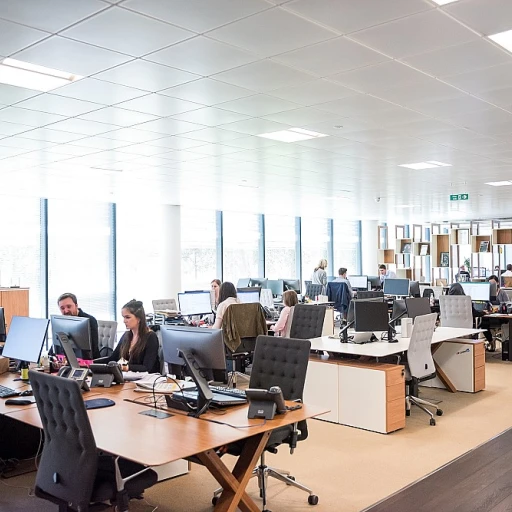
The Pillars of a Productive Office Culture
Establishing Core Values and Ethos
Productive office cultures are not born; they are cultivated with intention and strategy. A recent study by Deloitte found that 94% of executives and 88% of employees believe a distinct workplace culture is important to business success. This underscores the importance of building a foundational set of core values that resonate throughout the organization. Values like transparency, responsibility, and innovation act as the DNA of company culture, guiding behaviors and decision-making processes. For an office manager, nurturing a culture that thrives on these values means consistently aligning policies, recognitions, and daily practices with them, ensuring they're more than just words on a wall.
Empowering Employees and Encouraging Growth
According to LinkedIn's 2018 Workforce Learning Report, an astounding 93% of employees would stay at a company longer if it invested in their careers. This statistic reveals the significance of professional development within the office. As a management analyst, I've seen firsthand how empowering employees through training and growth opportunities breeds a productive and motivated workforce. When employees feel their employer is invested in their future, they reciprocate with deeper engagement and productivity. Examples include offering mentorship programs, skill-based training, and clear pathways for advancement.
Instilling a Sense of Community and Belonging
Humans are inherently social beings, and this doesn't change when we enter our places of work. Creating a sense of community within the office can substantially boost employee satisfaction. Data from TINYpulse’s Employee Engagement and Organizational Culture Report shows that camaraderie and peer motivation drive 20% of employees to go the extra mile. By organizing team-building activities, celebrating milestones, and creating collaborative workspaces, managers fortify relationships and foster a strong sense of belonging among team members. These strategies breed a positive office culture that champions unity and cooperation.
Addressing and Resolving Conflicts Constructively
Conflict is inevitable in any workplace. What distinguishes a productive office culture is the manner in which conflicts are resolved. Constructive conflict resolution strategies maintain the integrity of office dynamics and relationships. A study from CPP Inc.—publishers of the Myers-Briggs Assessment and the Thomas-Kilmann Conflict Mode Instrument—reveals that employees spend an average of 2.8 hours each week dealing with conflict, which means there is significant potential for impact on productivity. Office managers who address disputes with a focus on resolutions that benefit all parties, while upholding the company’s values, are building a resilient and collaborative workplace.
Embracing the Digital Transformation
There is no question that digital tools have transformed the modern workplace. A 2019 report by Mckinsey found that the use of social technologies in companies increases the productivity of high-skill workers by 20-25%. Incorporating project management software, collaborative apps like Slack or Microsoft Teams, and a multitude of other digital tools, facilitates seamless communication and efficient workflows. For the office manager, embracing digital transformation not only enhances team collaboration but also prepares the workforce to operate effectively within an increasingly digital economy.
Including Employee Feedback in Decision Making
Employee feedback is a cornerstone of a dynamic office culture. A Salesforce report states that employees who feel their voice is heard are 4.6 times more likely to feel empowered to perform their best work. Strategies for incorporating feedback range from surveys to suggestion boxes to regular one-on-one meetings. By actively seeking and acting upon employee input, office managers demonstrate respect for their team's opinions and foster a sense of ownership over the workplace culture. Furthermore, it often leads to innovative solutions that management may not have considered on their own, driving a culture of continuous improvement.
The Role of Leadership in Shaping Office Culture
Defining the Fundamentals of a Dynamic Office Environment
At the heart of every successful organisation lies a strong office culture. Statistics highlight that companies with strong cultures saw a 4x increase in revenue growth. A productive office culture is built on several pillars, including communication, teamwork, employee engagement, and wellness. These elements are not standalone; they intertwine to create an ecosystem that fosters productivity and job satisfaction. For instance, a Harvard Business Review article pinpointed that firms with high employee engagement scores had twice the customer loyalty. It is clear that prioritizing individual and group needs lays the groundwork for a thriving office culture.
Creating a Cohesive Communication Strategy
Effective communication is the keystone of any office management strategy. A study from McKinsey found that productive internal communication can lead to a 25% increase in employee productivity. This isn't just about ensuring messaging is clear and accessible—it's also about creating a dialogue. A true exchange of ideas and feedback between employees and management nurtures a healthy workplace culture where people feel valued and heard. Introducing platforms and tools that enhance communication can also help in maintaining transparency, a critical element for trust-building within teams.
Empowering Teams Through Engagement and Collaboration
Employee engagement is another integral pillar. Forbes states that highly engaged teams show 21% greater profitability. Engaged employees are more likely to bring passion and creativity to their roles, driving innovation. Office managers can ignite this engagement by offering development opportunities and recognizing individual contributions. Moreover, fostering collaboration through team-building activities and collaborative technologies can amalgamate individual strengths to achieve common goals, thus enriching office dynamics.
Ensuring Wellness and Work-life Balance
A focus on wellness and work-life balance is crucial for a productive office culture. The American Psychological Association reported that 91% of workers at companies that support well-being efforts feel motivated to do their best. Integrating wellness programs, flexible working options, and mental health days are examples of how companies can show they value their employees, not just the work they produce. By doing so, they nurture a culture that respects personal time and health, leading to reduced burnout and increased productivity.
Techniques for Enhancing Team Collaboration
Nurturing Leadership: The Heart of Workplace Culture
Leadership sets the tone for an office, providing the blueprint for what is considered acceptable and admirable within the workplace. The efficacy of leadership in cultivating a robust office culture is undeniable. Statistics indicate that leadership styles are directly connected to employee satisfaction and productivity levels. A study published by the Harvard Business Review found that leaders who prioritize employee well-being saw a 20% increase in performance. Leaders who excel in creating a nurturing environment do so through transparent communication, exhibiting integrity, and fostering a sense of trust and belonging. These qualities help to create a seamless bridge between organizational goals and individual employee values.
Cultivating a Culture of Respect inside the Office Ecosystem
The influence of leadership in fostering a respectful office culture cannot be overstated. By recognizing contributions and promoting equal opportunities, leaders enhance the sense of value among team members. One influential case example is that of Google's Project Aristotle, which revealed that the highest-performing teams were those that enjoyed psychological safety, a phenomenon significantly shaped by inclusive leadership. Furthermore, statistics from Deloitte have reiterated that inclusive cultures can lead to a whopping 83% increase in team performance.
Empowering Teams Through Visionary Leadership
An empowered workforce is the product of visionary leadership. By clearly outlining the company's vision, leaders can align the team's efforts toward shared objectives. In this context, setting clear and measurable goals is fundamental. For instance, a Gallup poll highlighted that a mere 22% of employees strongly agree that their leaders have a clear direction for the organization. Leaders who excel in strategic communication equip their teams with the motivation and context necessary to navigate their roles effectively, thereby driving up productivity and innovation.
Leadership's Role in Employee Growth and Development
As an office manager, supporting the ongoing growth and development of staff is crucial. This not only feeds into employee engagement but also serves the future needs of the company. Statistics from LinkedIn's Workplace Learning Report show that 94% of employees would stay at a company longer if it invested in their career development. By offering mentorship programs, continuous learning opportunities, and clear pathways for advancement, leaders can ensure that employees feel their growth is taken seriously. This investment in human capital is integral to a thriving office culture.
Implementing Change: The Leader as a Catalyst
In today's fast-paced business landscape, the ability of leadership to implement and manage change is vital for maintaining a dynamic and productive office culture. Leaders are often the catalysts for change, making decisions that can either propel a company forward or hinder its progress. Quoting John Kotter, a professor at Harvard Business School, 'Leadership defines what the future should look like, aligns people with that vision, and inspires them to make it happen despite obstacles.' In this regard, leaders must be adept at navigating the complexities of change management, ensuring that their teams are well-prepared and resilient in the face of new challenges.
Final Thoughts on Leadership Influence
The intangible qualities of effective leadership such as empathy, decisiveness, and the ability to inspire, go hand in hand with more measurable attributes like turnover rates, engagement scores, and productivity levels. Ultimately, it's a combination of these soft and hard skills that contribute to the cultivation of a positive office culture. By embracing their role as culture champions, leaders can create an office environment where innovation thrives, team collaboration is the norm, and every employee feels valued and understood.
Monitoring and Measuring Workplace Satisfaction
Empowering Synergy: Effective Strategies for Team Collaboration
In today's fast-paced business environment, team collaboration is the cornerstone of any productive office culture. Statistics from renowned business journals indicate that organizations with high levels of collaboration are five times more likely to be high-performing. It's no longer just about group work; it's about empowering each member to contribute their best through strategic collaboration techniques.
- Utilize Collaborative Technology: Tools like Asana, Slack, and Trello have revolutionized the way teams interact and manage projects. With real-time updates and integrations, these platforms can increase transparency and facilitate seamless communication.
- Foster a Collaborative Mindset: Encourage an office atmosphere where each member's ideas are valued. Celebrate collaborative successes and consider offering team-building activities to strengthen interpersonal relationships.
- Implement Cross-Functional Workshops: Regular workshops or meetings with cross-departmental team members can spark innovation and creative solutions, breaking down silos within the organization.
Experts suggest that the integration of such collaborative approaches into daily workflows can decrease project completion times by up to 20%, illustrating the direct impact of collaboration on productivity.
Designing Spaces for Collaborative Success
Physical space plays a significant role in how effectively teams collaborate. Open-floor plans and flexible workspaces have become popular in fostering a collaborative environment. Quotes from leading office design consultants highlight the importance of spaces that adapt to various collaborative needs - from quiet zones for focused work to open areas for brainstorming sessions.
Leverage office layout to facilitate conversation and idea exchange with strategic seating arrangements and communal areas. The 'bump factor' where employees naturally encounter each other can increase the likelihood of spontaneous idea sharing and innovation.
Cultivating Communication Skills for Better Collaboration
Effective communication is the lifeblood of successful collaboration. Provide training in active listening, clear articulation of ideas, and constructive feedback to enhance team dynamics. According to the Harvard Business Review, teams with strong communication skills are up to 25% more productive than their counterparts.
Incorporating these techniques for enhancing team collaboration not only leads to improved efficiency and innovation but also fosters a sense of unity and satisfaction among employees, as reflected in workplace satisfaction metrics. By nurturing these strategies, office managers are paving the way for a more dynamic and productive office culture that is geared towards success in an ever-evolving business landscape.


-large-teaser.webp)
